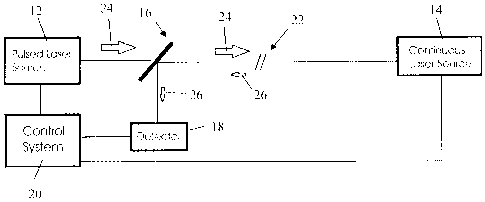Une partie des informations de ce site Web a été fournie par des sources externes. Le gouvernement du Canada n'assume aucune responsabilité concernant la précision, l'actualité ou la fiabilité des informations fournies par les sources externes. Les utilisateurs qui désirent employer cette information devraient consulter directement la source des informations. Le contenu fourni par les sources externes n'est pas assujetti aux exigences sur les langues officielles, la protection des renseignements personnels et l'accessibilité.
L'apparition de différences dans le texte et l'image des Revendications et de l'Abrégé dépend du moment auquel le document est publié. Les textes des Revendications et de l'Abrégé sont affichés :
| (12) Demande de brevet: | (11) CA 2629902 |
|---|---|
| (54) Titre français: | DETECTION ET LOCALISATION DE FISSURES DANS DES CAPTEURS DISTRIBUES BRILLOUIN DE FIBRE |
| (54) Titre anglais: | DETECTION AND LOCATION OF BREAKS IN DISTRIBUTED BRILLOUIN FIBER SENSORS |
| Statut: | Réputée abandonnée et au-delà du délai pour le rétablissement - en attente de la réponse à l’avis de communication rejetée |
| (51) Classification internationale des brevets (CIB): |
|
|---|---|
| (72) Inventeurs : |
|
| (73) Titulaires : |
|
| (71) Demandeurs : |
|
| (74) Agent: | MACRAE & CO. |
| (74) Co-agent: | |
| (45) Délivré: | |
| (22) Date de dépôt: | 2008-04-25 |
| (41) Mise à la disponibilité du public: | 2008-10-26 |
| Licence disponible: | S.O. |
| Cédé au domaine public: | S.O. |
| (25) Langue des documents déposés: | Anglais |
| Traité de coopération en matière de brevets (PCT): | Non |
|---|
| (30) Données de priorité de la demande: | ||||||
|---|---|---|---|---|---|---|
|
An apparatus for an optical time domain analyzer is provided. The apparatus
has a
pulsed laser source and a continuous wave (CW) laser source. The apparatus
also has a
computer readable memory for detection of a reflected pulse of an outgoing
pulse from
the pulsed laser source, the reflected pulse being reflected from a break in
the fiber or an
unterminated end of the fiber. In another embodiment, a computer program
product
having memory with computer readable code embodied therein is provided for
determining a distance to a break or fiber end in an optical fiber. The
computer program
has means for detecting an outgoing pulse from a pulsed laser source in an
optical time
domain analyzer, means for detecting a reflected pulse and means for
determining the
timing of the reflected pulse relative to the outgoing pulse.
Note : Les revendications sont présentées dans la langue officielle dans laquelle elles ont été soumises.
Note : Les descriptions sont présentées dans la langue officielle dans laquelle elles ont été soumises.

2024-08-01 : Dans le cadre de la transition vers les Brevets de nouvelle génération (BNG), la base de données sur les brevets canadiens (BDBC) contient désormais un Historique d'événement plus détaillé, qui reproduit le Journal des événements de notre nouvelle solution interne.
Veuillez noter que les événements débutant par « Inactive : » se réfèrent à des événements qui ne sont plus utilisés dans notre nouvelle solution interne.
Pour une meilleure compréhension de l'état de la demande ou brevet qui figure sur cette page, la rubrique Mise en garde , et les descriptions de Brevet , Historique d'événement , Taxes périodiques et Historique des paiements devraient être consultées.
| Description | Date |
|---|---|
| Demande non rétablie avant l'échéance | 2012-04-25 |
| Le délai pour l'annulation est expiré | 2012-04-25 |
| Réputée abandonnée - omission de répondre à un avis sur les taxes pour le maintien en état | 2011-04-26 |
| Demande publiée (accessible au public) | 2008-10-26 |
| Inactive : Page couverture publiée | 2008-10-26 |
| Inactive : CIB attribuée | 2008-09-30 |
| Inactive : CIB attribuée | 2008-09-30 |
| Inactive : CIB attribuée | 2008-09-30 |
| Inactive : CIB en 1re position | 2008-09-30 |
| Inactive : Certificat de dépôt - Sans RE (Anglais) | 2008-06-16 |
| Exigences relatives à une correction d'un inventeur - jugée conforme | 2008-06-16 |
| Demande reçue - nationale ordinaire | 2008-06-06 |
| Exigences de dépôt - jugé conforme | 2008-06-06 |
| Inactive : Certificat de dépôt - Sans RE (Anglais) | 2008-06-06 |
| Date d'abandonnement | Raison | Date de rétablissement |
|---|---|---|
| 2011-04-26 |
Le dernier paiement a été reçu le 2010-01-19
Avis : Si le paiement en totalité n'a pas été reçu au plus tard à la date indiquée, une taxe supplémentaire peut être imposée, soit une des taxes suivantes :
Veuillez vous référer à la page web des taxes sur les brevets de l'OPIC pour voir tous les montants actuels des taxes.
| Type de taxes | Anniversaire | Échéance | Date payée |
|---|---|---|---|
| Taxe pour le dépôt - générale | 2008-04-25 | ||
| TM (demande, 2e anniv.) - générale | 02 | 2010-04-26 | 2010-01-19 |
Les titulaires actuels et antérieures au dossier sont affichés en ordre alphabétique.
| Titulaires actuels au dossier |
|---|
| OZ OPTICS LTD. |
| Titulaires antérieures au dossier |
|---|
| GORDON DAVID YOULE |
| OMUR M. SEZERMAN |